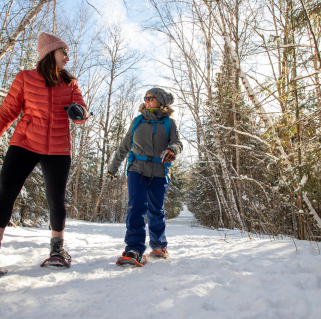Pamela Merritt
May 28, 2014
Adirondack Lakes and Rivers Paddles
Kayaking and canoeing in the Adirondacks, especially in the lake country near Saranac Lake, has an abundance of paddling possibilities. We are home to the 18,400-acre St. Regis Canoe Area. This is the only designated Canoe Area in all of New York State, with almost sixty bodies of water to explore, each with their own charm.
This broad and untouched wilderness is much more accessible than we might think. After my trip, with two guides from St. Regis Canoe Outfitters, I think that paddling the Adirondacks is the very best way to explore it too!
The Seven Carries started as a Gilded Age pastime, breaking trails between these ponds and the Great Camps and Grand Hotels of the era. Some of these landmarks remain, such as the golf course at Saranac Inn Golf & Country Club. This was the course belonging to Saranac Inn Resort, which once could host a thousand guests. Now, the Seven Carries is a delightful day trip, or a foundation for several days of camping and exploring.
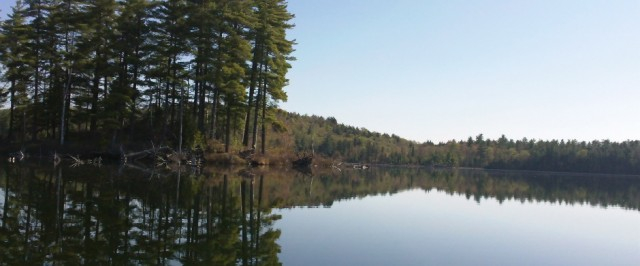
Where to begin
A popular place to start is at Little Clear Boat Launch. This gets the longest carry (6/10th of a mile) out of the way first, so our carry trails will get shorter at every stop. Little Clear is known for its tranquility, since the only allowed activity is canoes or kayaks. It is a brood pond for the Fish Hatchery, and that great fishing is only for the loons. Which are many... I saw seven of them this morning. This amazing bird has a distinctive profile as they sit low in the water, and frequently disappear completely as they dive for fish. Bring your binoculars!
Little Clear is only "little" by comparison to Lake Clear. We had much delightful paddling time, pointing out loons to each other and enjoying the mirror images in the calm water. It could only be bettered with a dawn arrival, with the rising sun tinting the water pink, and the many loons making their distinctive early morning calls.
With the help of our waterproof paddling map (designed and sold by my guides) we found the first portage point, marked with a small white sign. I felt great excitement at stepping on a path made by Adirondack adventurers from over a century ago.

What is Portage?
Portage is the time-honored art of "wearing a canoe on your head." There are padded yokes which fit into the midsection of the canoe to make balancing, and carrying, easier. Modern materials are also lighter than back in the day. My guide shoulders our two-person canoe, and I carry the paddles, life vests, and our lunches. The path is broad, the day is sunny, and the early season leaves are just forming. It's a fun hike for me.
Our next destination is Saint Regis Pond. The end of the portage is a wooden boardwalk which protects fragile bogland. These plants are more colorful than the green forest we've left behind, with maroon-red pitcher plants to delight the child in all of us. We set off through a path traced through the bog by the many canoes which have come before us. It opens out onto a large body of water with distant mountains visible from many points.
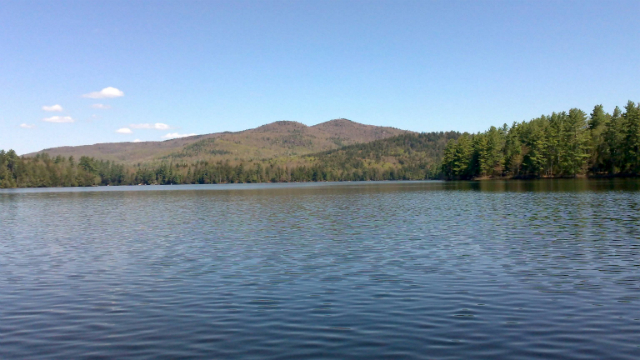
What to explore
There are wilderness camping spots throughout this area, assigned by permit, and often rotated to let the land regenerate from human wear. We were going to stop at a lean-to on the shore of the pond, but it's already occupied by a camper. We are not disappointed, because there's plenty of other areas to explore.
This pond has a widely varying shoreline; from bogs to snags to forests growing right to the edge of short rocky bluffs. This makes for a scenic paddle with the view changing often, as the different bays offer new viewpoints, and enough distance to see beyond the trees to the top of Saint Regis Mountain and its firetower (currently being restored.)
It is also known for having some of the most interesting islands. We make land on one which has that dream of every lady explorer... a privy.
My guide finds some lovely blooms, including that beloved Adirondack wildflower, the trillium. There's also the hardy, delightful-smelling, wintergreen, considered the "Adirondack mint" because it grows in moist sub-alpine mountain forests. This island, surrounded by water, certainly qualifies.
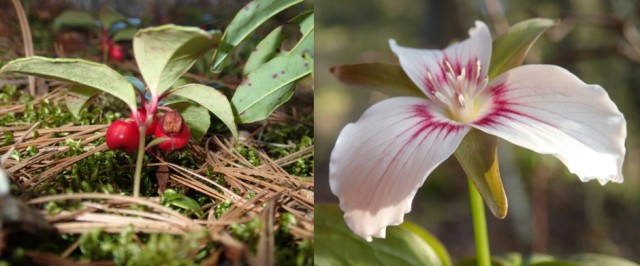
We hug the shore for scenic reasons, but not too closely. This untouched area has downed trees which can lurk under the water for the unwary paddler, and they don't always have branches to stick up as a warning. But there is a good side to this natural cycle. It creates micro-environments which fish prefer.
Our next stop is Green Pond, such a simple carry that we don't bother with portage. The two of us carry each end of the canoe to reach this charming, square, pond. The shore has flowering trees and the water really is a shimmering shade of green.
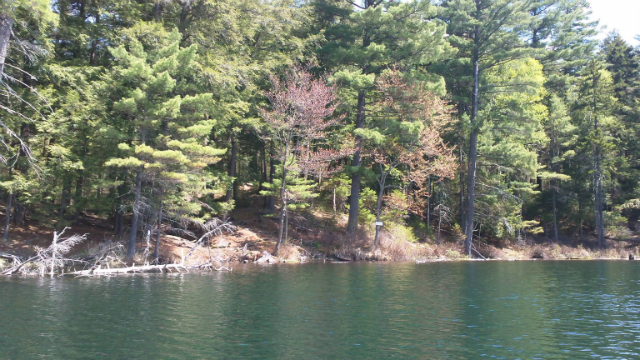
Little Long Pond is a long narrow pond, and we paddle most of it by going from one portage point to another. This is a great illustration of how much easier it is to travel by canoe than it would be walking the distance, even if there were trails. Which there are not.
This nine to twelve mile distance for canoe would be a very different trip if we were bushwhacking through this same area. We have been on the water from nine in the morning and we are now thinking about lunch. If we were struggling through the forest, we would probably still be thinking about lunch, but we would be way back in the forest behind us. Native Americans and early settlers alike preferred the broad and easy path our abundant lakes provide.
Another short portage brings us to Bear Lake, known for its turquoise water. Here we meet up with a guide's wife and the family beagle. We settle on a lovely island for our lunch, one with a little sunny meadow in the middle. Out on the water we have a continuous breeze, both by our efforts and the wind on the water. Once nestled in our meadow, with sheltering trees all around, the sun warms us enough that we shed a few layers.

What to Wear
Layers are the key to comfort. When we set out, there was a morning breeze that was cooled even more by the lake's long night. As the sun rose, and the day warmed, I dropped my light jacket. After lunch, I was so warm I was tempted to strip down to my lowest T-shirt layer, but I knew I would be cooler once back on the water.
Our hats and jackets, if well-chosen, can also act as sunscreen, in a way that cannot wear off or wash off. My own hat has a screened crown and I have a very thin, though long-sleeved, middle layer. Do be careful! Even people who think they have a sufficient tan might not be thinking of how long hours and water reflections can accumulate to high levels of sun exposure.
Between Bear Pond and our final destination there is one more small pond, the well-named Bog Pond. The central water seems like any other, but the fringes are rich with the lacy bog plants. The winding route through the western end of Bog Pond, to make our next carry, is magical. The plants crowd close and offer warm pastel colors after so much green and blue.
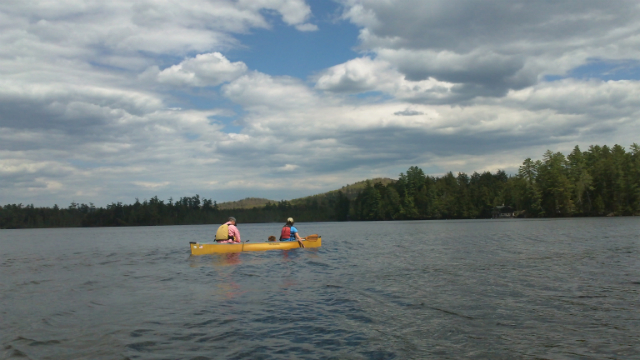
What's the secret?
We had a late lunch and reach our final stop in mid-afternoon. That is seven ponds... and only six carries! Yes, that's the secret of the Seven Carries -- the historical name no longer fits, as the final carry would have been to a resort hotel no longer in existence. So we start the trip one carry "up."
Upper Saint Regis Lake is yet another distinctly different lake, as it allows for motor crafts and has a large number of private homes, as well as historic Great Camps, on its shores. Our plan is to traverse the lower section of the lake to reach the boat launch at the southern end.
Experiencing so much nature in our route makes the trip across the lake a transition from the primeval to the modern. After a day on the water and exploring the wilderness, civilization is even more appreciated. Hospitality was the destination of people doing the Seven Carries over a hundred years ago, and it works the same way now.
A delicious meal, maybe some music or a play, and a cozy room are all the more appreciated at the end of such a great day.
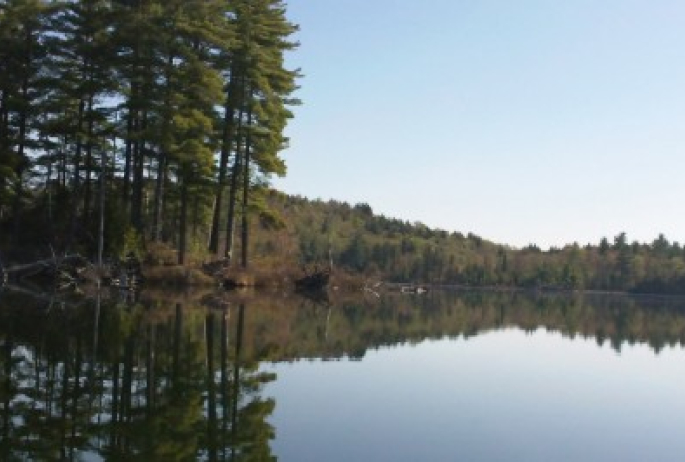

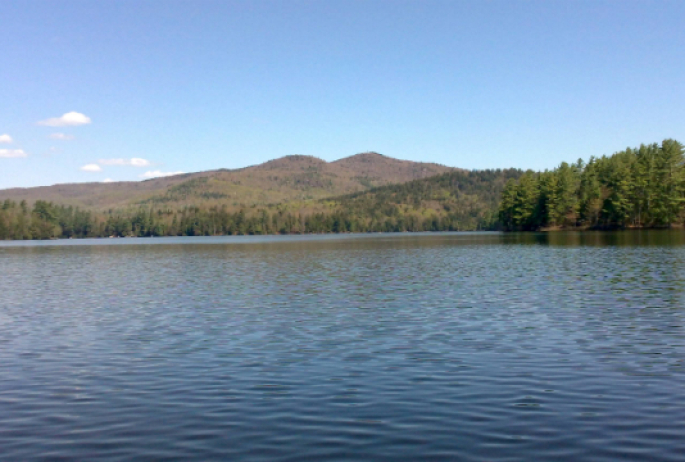
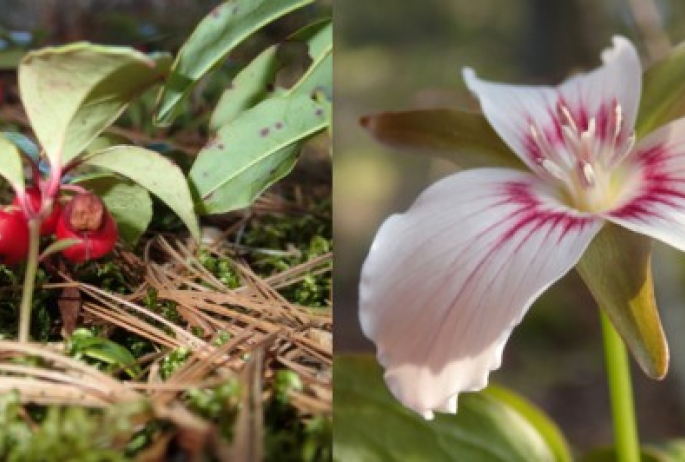
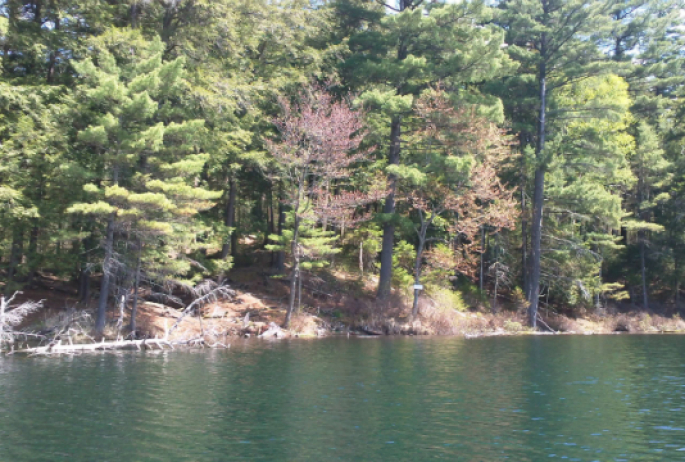
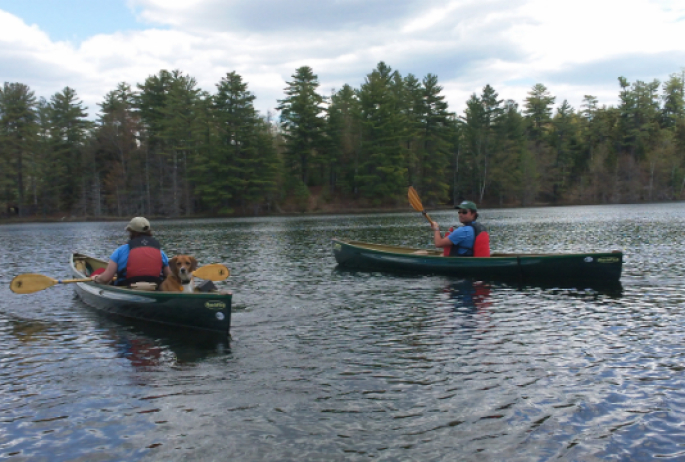
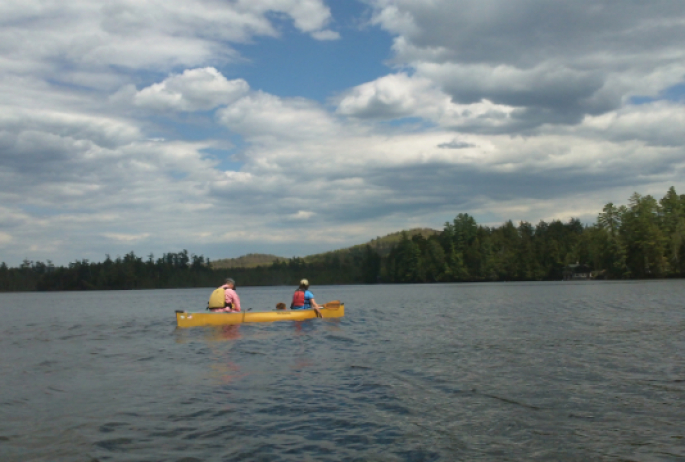
Packages and Promotions
Valid Jan. 16
- Mar. 31
Valid Jan. 16
- Mar. 31
Hotel Saranac Ski & Stay Package
Hotel Saranac
Stay & Ski Package Stay at Hotel Saranac and Ski Titus Mountain Day or Night Package Your room reservation includes one adult lift ticket....
Valid Dec. 1
- Dec. 1
Valid Dec. 1
- Dec. 1
Linger Longer in Saranac Lake
Best Western Saranac Lake
Linger Longer in Saranac Lake at our supremely located property, Best Western Saranac Lake. Stay 2 nights or more and get 15% off!
Valid Jan. 16
- Mar. 31
Valid Jan. 16
- Mar. 31
Hotel Saranac Sled & Spoke Package
Hotel Saranac
Snowmobile Package Hotel Saranac and Sara-Placid Sled & Spoke have partnered so you and a guest can explore dozens of miles of ADK snowmobile...
Valid Jan. 21
- Jan. 21
Valid Jan. 21
- Jan. 21
Pet Getaway
Voco Saranac Lake
Your dog deserves an Adirondack getaway too. Book our pet friendly hotel near Lake Placid welcomes every member of your crew. Book our Pet Package...
Valid Jan. 21
- Jan. 21
Valid Jan. 21
- Jan. 21
Stay and Dine
Voco Saranac Lake
Receive a 50 dollar credit per stay to use in our Boathouse Saranac Lake Pub. Enjoy an exceptional dining experience with unparalleled views great...
Valid May. 1
- Oct. 31
Valid Dec. 6
- Nov. 1
Zip and Whip Expedition
Farmhouse UTVs
Experience Outdoors and Farmhouse UTVs have teamed up to bring your family and friends the Adirondack adventure you've been waiting for....
Valid Jun. 20
- Sep. 7
Valid Mar. 12
- Jun. 30
Guided Nature Immersions - 10% off for Pre-Season Registration
Adirondack Riverwalking & Forest Bathing
Picture it now...you are wading the Ausable River on a warm summer day, feel the cool water against you, hear the sounds of the birds and the...
Valid Jan. 21
- Mar. 31
Valid Jan. 21
- Mar. 31
Titus Mountain Ski Package
Voco Saranac Lake
Enjoy your stay at the award winning voco Saranac Lake which includes two adult lift tickets at Titus Mountain Family Ski Center. Additional...

